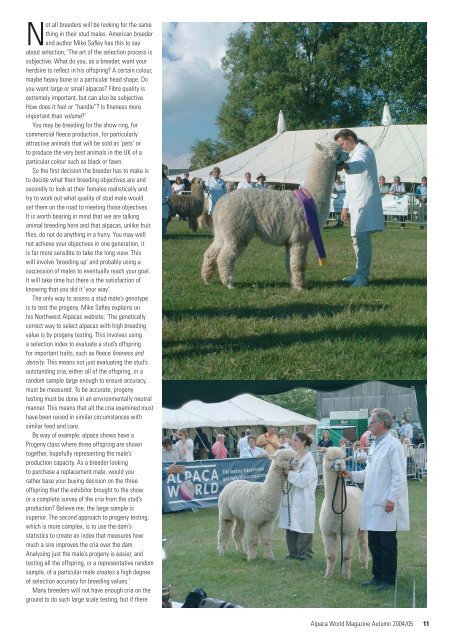Create successful ePaper yourself
Turn your PDF publications into a flip-book with our unique Google optimized e-Paper software.
Not all breeders will be looking for the same<br />
thing in their stud males. American breeder<br />
and author Mike Safl ey has this to say<br />
about selection; ‘The art of the selection process is<br />
subjective. What do you, as a breeder, want your<br />
herdsire to refl ect in his offspring? A certain colour,<br />
maybe heavy bone or a particular head shape. Do<br />
you want large or small alpacas? Fibre quality is<br />
extremely important, but can also be subjective.<br />
How does it feel or “handle”? Is fi neness more<br />
important than volume?’<br />
You may be breeding for the show ring, for<br />
commercial fl eece production, for particularly<br />
attractive animals that will be sold as ‘pets’ or<br />
to produce the very best animals in the UK of a<br />
particular colour such as black or fawn.<br />
So the fi rst decision the breeder has to make is<br />
to decide what their breeding objectives are and<br />
secondly to look at their females realistically and<br />
try to work out what quality of stud male would<br />
set them on the road to meeting those objectives.<br />
It is worth bearing in mind that we are talking<br />
animal breeding here and that alpacas, unlike fruit<br />
fl ies, do not do anything in a hurry. You may well<br />
not achieve your objectives in one generation, it<br />
is far more sensible to take the long view. This<br />
will involve ‘breeding up’ and probably using a<br />
succession of males to eventually reach your goal.<br />
It will take time but there is the satisfaction of<br />
knowing that you did it ‘your way’.<br />
The only way to assess a stud male’s genotype<br />
is to test the progeny. Mike Safl ey explains on<br />
his Northwest <strong>Alpacas</strong> website; ‘The genetically<br />
correct way to select alpacas with high breeding<br />
value is by progeny testing. This involves using<br />
a selection index to evaluate a stud’s offspring<br />
for important traits, such as fl eece fi neness and<br />
density. This means not just evaluating the stud’s<br />
outstanding cria; either all of the offspring, or a<br />
random sample large enough to ensure accuracy,<br />
must be measured. To be accurate, progeny<br />
testing must be done in an environmentally neutral<br />
manner. This means that all the cria examined must<br />
have been raised in similar circumstances with<br />
similar feed and care.<br />
By way of example, alpaca shows have a<br />
Progeny class where three offspring are shown<br />
together, hopefully representing the male’s<br />
production capacity. As a breeder looking<br />
to purchase a replacement male, would you<br />
rather base your buying decision on the three<br />
offspring that the exhibitor brought to the show<br />
or a complete survey of the cria from the stud’s<br />
production? Believe me, the large sample is<br />
superior. The second approach to progeny testing,<br />
which is more complex, is to use the dam’s<br />
statistics to create an index that measures how<br />
much a sire improves the cria over the dam.<br />
Analysing just the male’s progeny is easier, and<br />
testing all the offspring, or a representative random<br />
sample, of a particular male creates a high degree<br />
of selection accuracy for breeding values.’<br />
Many breeders will not have enough cria on the<br />
ground to do such large scale testing, but if there<br />
Alpaca World Magazine Autumn 2004/05 11







